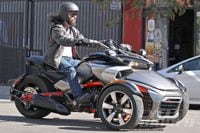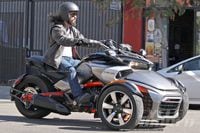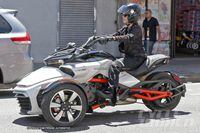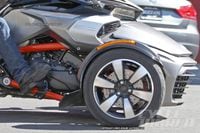Recently, Chris Doane’s spy photographers in Germany and California captured photos of what is presumably one of next year’s crop of Can-Am Spyder three-wheelers, and the photos make clear that BRP/Can-Am has radically altered its approach to the Spyder styling and design.
The new machine's frame is a big departure from the previous "SST" frame (Surrounding Spar Technology, in Can-Am speak) and seems to use large-diameter tubes to hang everything together. The bodywork has been dramatically changed, nowhere more obviously than on the sides of the engine-transmission area, where, for the first time, significant sections of the powertrain are visible, in keeping with the traditional motorcyclists' preferences. It looks as if the engine is the new-for-2014 1330cc inline triple, a transverse fuel-injected dohc powerplant that couples to either the SE6 six-speed electro-hydraulically shifted transmission or a conventional foot-shifted six-speed. But what is all-new is the position of the rider's footpegs; rather than being under or just forward of the rider, they are now positioned farther forward, leaving the riders' legs extended, with the shifter and brake lever positioned so that the rider's feet are cocked up, a la a chopper.
In front, the bodywork “language” is rectilinear, a design theme reminiscent of mid-’60s formula race cars or more recent in-your-face truck “faces” than the old swooped nose, which one designer said reminded him of a demon. This low, flattened lozenge-style front end might change how much the front compartment can hold, but clearly this machine is not about storage, it’s about street style. Thus, the side view shows how long and low the thing is. With its swept-back handlebars, foot-forward riding position and out-there-in-full-view mechanical presence, this Spyder could not be more different, visually, from its predecessor. It still seems to feature the same steering system, signifying that the leaning-to-turn Spyder known to have been patented by BRP is still in the future, but it might well be that this new version is much lighter than its predecessor too, so it might be quicker, if not faster, and might even handle better. Only testing a production model will tell that tale.
It’s important, when looking at these images, to observe closely the riders and gear chosen by BRP to appear on the machines; the look is all-black, hip, urban, and cool, and if there is a similarity between this Spyder and any previous motorcycle I can think of, based entirely on styling, it might be the Yamaha V-Max. The side scoops on the area below the vestigial windshield and cockpit coaming area seem to be there for visual effect as well as wind/cooling and location of auxiliary lights, and add to the frankly masculine look of the Spyder. This is in stark contrast with the previous version too, which many motorcyclists seem to have derided because its swoopy bodywork—called “Tupperware” by many Spyder Ryders—suggested nothing like the long-low-mean look this thing owns. It’s tempting to speculate that this redesign means that Can-Am has shifted at least part of its Spyder marketing strategy from selling to “non-nons” (people with no previous powersports or motorcycle experience) to attracting younger, hipper, riders, among them more men who want a tougher look to get that all-important street cred, which, it seems fair to observe, the original Spyder “sport” did not much generate.
If nothing else, this radical redesign of the Spyder makes clear that BRP/Can-Am is in the game to stay and to fight everyone for market success. Just how good the redesign is in functional terms will be determined when we test the new Spyder.





/cloudfront-us-east-1.images.arcpublishing.com/octane/MDGADBIEPJHWRN7BCU4XOARMFY.jpg)
/cloudfront-us-east-1.images.arcpublishing.com/octane/MKRUHX4KCFEUHCCI4WJBTDEDYI.jpg)
/cloudfront-us-east-1.images.arcpublishing.com/octane/WLXCPQXCHZB67PRYETNX4MOFOM.jpg)
/cloudfront-us-east-1.images.arcpublishing.com/octane/EWQ5RL2PZNGE7HPSOYFYHODTHU.jpg)
/cloudfront-us-east-1.images.arcpublishing.com/octane/HOCJQYQIAFEYJG5OUS2E2EFXFA.jpg)
/cloudfront-us-east-1.images.arcpublishing.com/octane/QYVHW53X5JDKZOHIW7QQVGZTTQ.jpg)
/cloudfront-us-east-1.images.arcpublishing.com/octane/TN52X7NPP5FFVFP4PAXLLDBZZ4.jpg)
/cloudfront-us-east-1.images.arcpublishing.com/octane/BN74KGDB2NDNFJ65JMYE45C6YQ.jpg)


/cloudfront-us-east-1.images.arcpublishing.com/octane/3ZKIVLW4BBHV7FSYYODYL55OIQ.jpg)
/cloudfront-us-east-1.images.arcpublishing.com/octane/BW43XOMS5RA2RB5QLEXD4NTNYE.jpg)
/cloudfront-us-east-1.images.arcpublishing.com/octane/GMG6KKHK4ZDLBFILW6L5UHJC4M.jpg)
/cloudfront-us-east-1.images.arcpublishing.com/octane/6BQBLTD22JHEFH2OBE5ZGY74NU.jpg)
/cloudfront-us-east-1.images.arcpublishing.com/octane/OVNMRSCISBB2FG4GQLQAYN56MU.JPG)
/cloudfront-us-east-1.images.arcpublishing.com/octane/7KSW4EGJWBGKFA62G4OARG7POU.jpg)
/cloudfront-us-east-1.images.arcpublishing.com/octane/OX5X6DCDXRBHBDLSLR2PRRJMSE.jpg)
/cloudfront-us-east-1.images.arcpublishing.com/octane/4FN63Z3XEVBMBDP3W6GFPLICRU.jpg)
/cloudfront-us-east-1.images.arcpublishing.com/octane/2CYHINRF5RA7VBO3PRJPVU5IBE.jpg)
/cloudfront-us-east-1.images.arcpublishing.com/octane/X7JX7MGA5ZBCDGDVAA2LKUGCTQ.jpg)
/cloudfront-us-east-1.images.arcpublishing.com/octane/7TO4TMPM6JBJJPBWUMT35TJHHA.jpg)
/cloudfront-us-east-1.images.arcpublishing.com/octane/3CANJMY47BH6BNPDAODAUD3CWQ.jpg)
/cloudfront-us-east-1.images.arcpublishing.com/octane/4IGJJZ6HWNAIHJ343U7CUH4WC4.jpg)
/cloudfront-us-east-1.images.arcpublishing.com/octane/BP5NOY5NPVGOZIDU5FN7M42JMA.jpg)